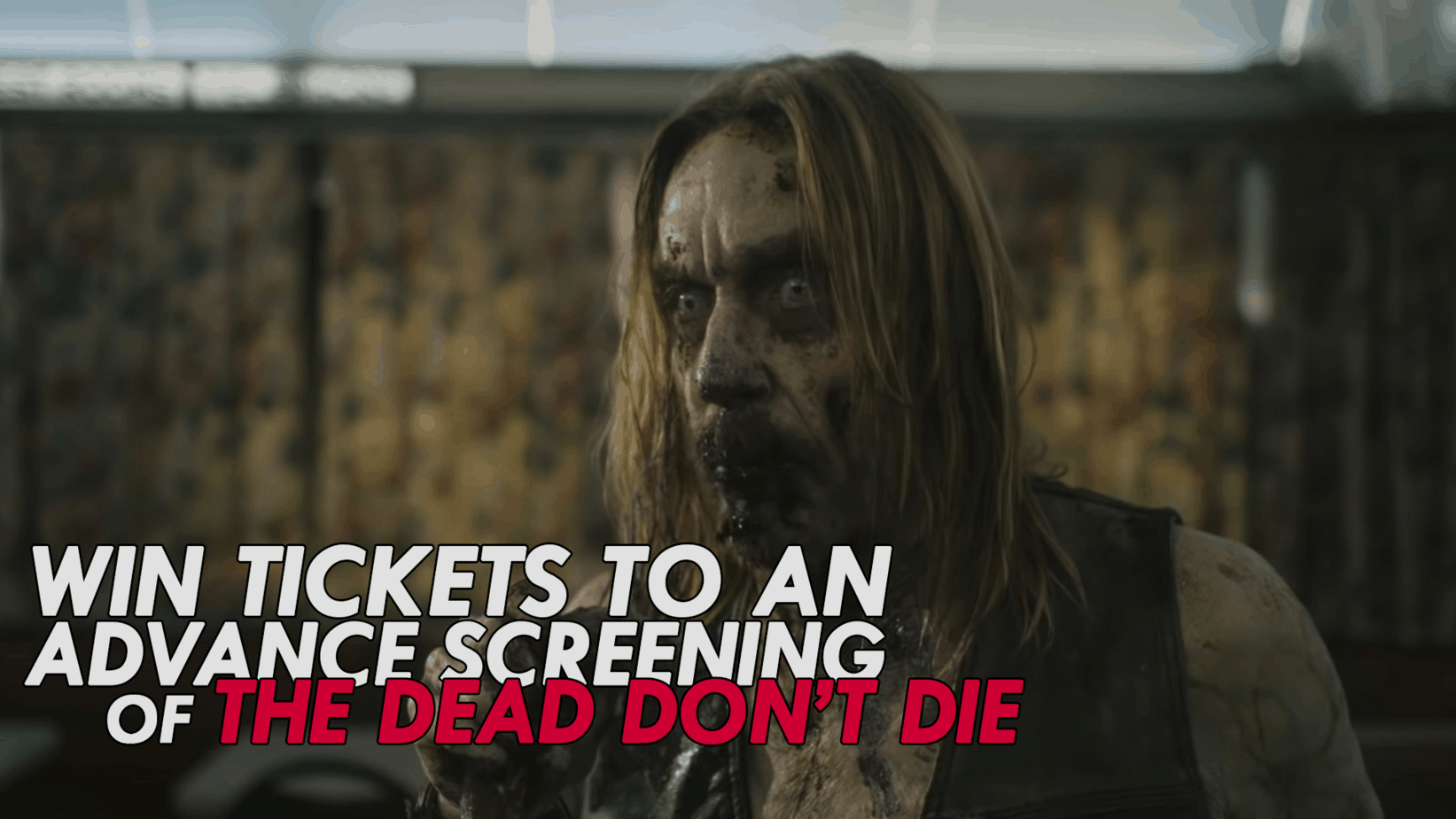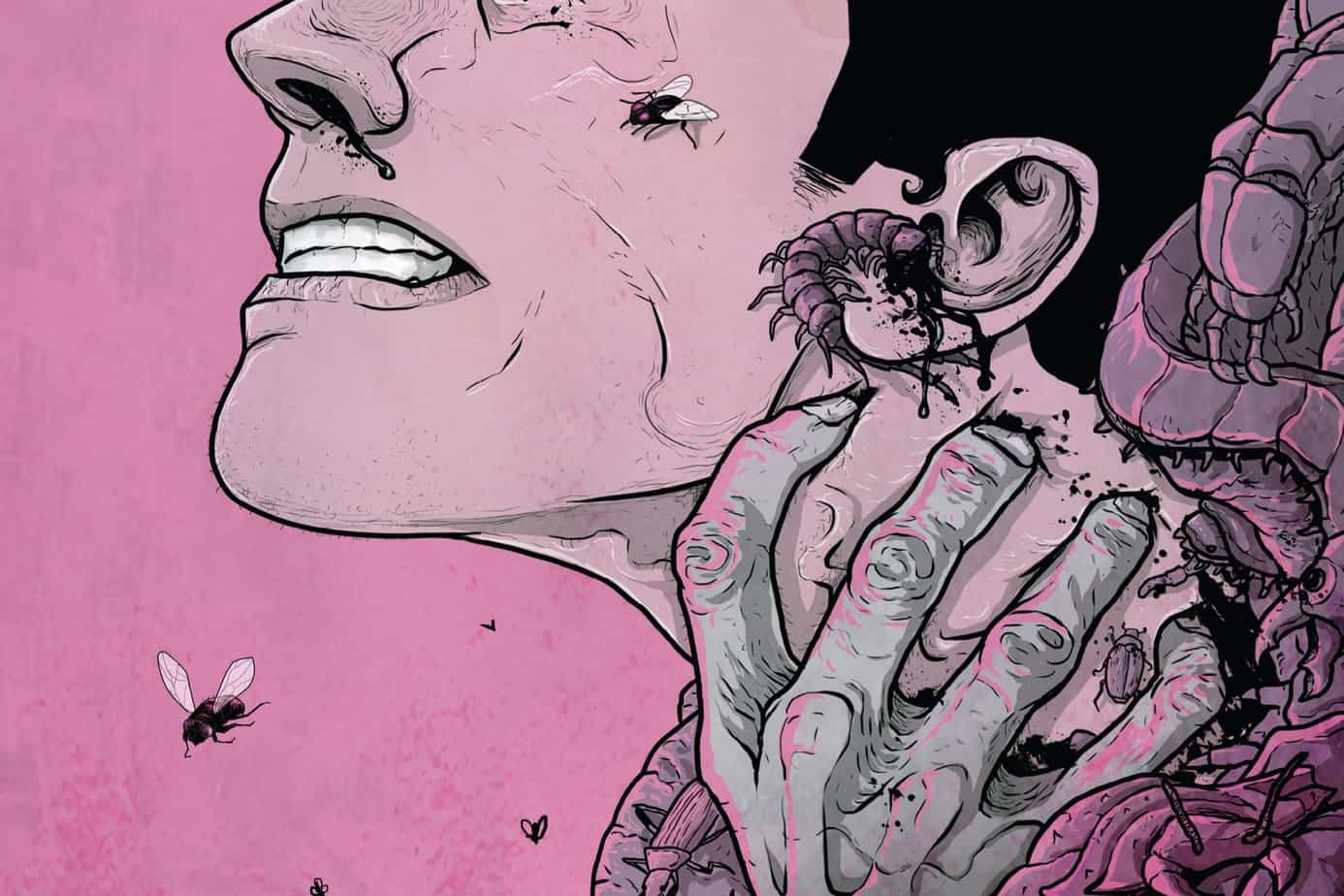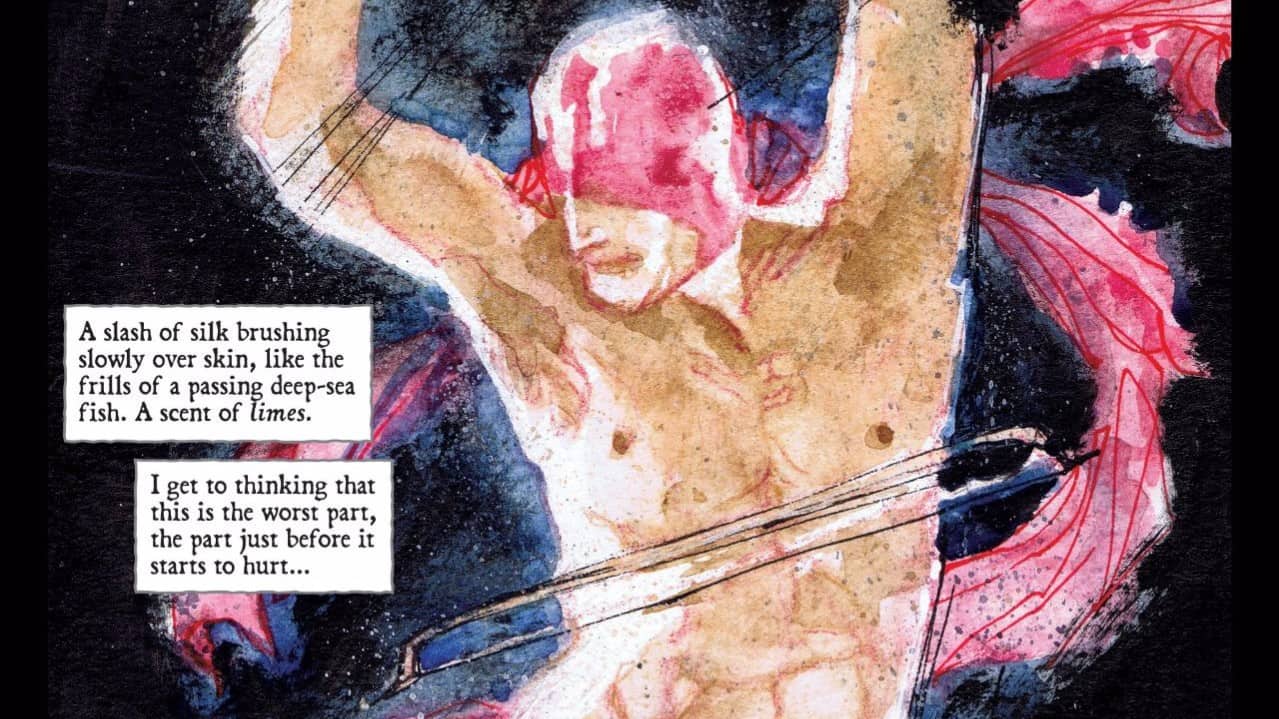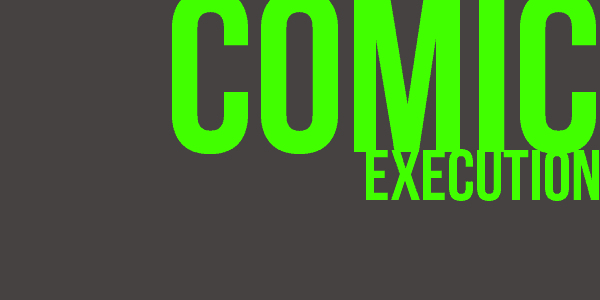
[Comic Execution] 4/5 – ‘CALIBAN’, ”68: RULE OF WAR’, ‘TUROK’
So I recently reviewed Steve Orlando’s ‘Undertow’ and complained, as part of my criticism, that the comic had plenty of gratuitous female nudity while what little manflesh we saw was of the humiliated and non-sexual variety. Steve contacted me and informed me about his history with queer themes in his previous comics. Which is to say, all his comics have been about as diverse as possible, except ‘Undertow,’ which challenges the audience in the sense that these are not human creatures they may or may not be ogling, as he implied. He also gave me some more of his own reasonings behind why certain characters were so openly sexualized in ‘Undertow’.
After thinking about our conversation for a while, I’m not as reassured by his response as I was initially. “…so I sort of LOLed because this is the first time I sat back and didn’t explicitly push the gay agenda” kept nagging at me later on. First, let me point out that we were using the term “gay agenda” somewhat satirically, as we both understood that there’s no agenda, just a very human desire for more visibility in comics. Second, as I continued to read more Image Comics titles that, again, soundly lacked the very diversity that Steve has been so fervent about in his prior work, I couldn’t help wishing that Steve HAD “pushed the gay agenda” in ‘Undertow’ and wondering what had stopped him from doing so. Why, on his most high profile work he’d done so far, was he silent on the aforementioned topic? I didn’t ask this question outright because, frankly, it would’ve been rude.
But then that makes me a coward, doesn’t it? And certainly in no position to question Steve’s integrity or motivation in the least.
 CALIBAN #1
CALIBAN #1
Writer: Garth Ennis
Artist: Facundo Percio & Sebastian Cabrol
Colors: Hernan Cabrera
Publisher: Avatar Press
Price: $4 (Digital)
Garth Ennis is a comic book writer. He’s definitely an A-list writer and his landmark title ‘Preacher’ is monolithic, but, despite being prolific and highly respected, he doesn’t have the stardom of his peers like Warren Ellis or Scott Snyder, whose names alone will launch a title. Like Warren Ellis, his work’s been adapted into movie form; Ellis had RED while Ennis’ ‘Dangerous Habits’ storyline from the HELLBLAZER series was the core of the Keanu Reeves movie. Snyder singlehandedly revitalized the Batman comics in the wake of DC’s reboot and, perhaps more impressively, has lived up to the expectations that Nolan’s movies set. Part of the issue is that Ennis’s output of late has primarily been with Avatar Press, whose infamy is well known, and that’s in part due to the controversial ‘Crossed,’ an Ennis creation itself. The other stuff he’s done for Avatar hasn’t been as outrageous but it has definitely maintained an air of defiant inaccessibility. ‘Caliban’ might be the first thing he’s done in a while that’s doesn’t advertise transgressive themes or gory violence as a selling point.
And it really is a decidedly different Ennis, from page one, as we’re gently introduced to the crew of Caliban. Well, as gently as Ennis can manage, dividing them into the hardened but tactful women and the men, all of whom lack any of the dignity of their counterparts. Fortunately, Ennis makes a point about how they’re out there on their own and, should something go wrong, they’re good as dead if not already, and that made me think about what sort of personality types you’d have attracted to the idea of putting their life on the line for a big payout from a faceless interstellar mining corporation. And fortunately, the characters are shaded enough that they don’t feel entirely like stereotypes, just people who shouldn’t be working together, much isolated in space by themselves.
Then, to my surprise, Ennis drops the hammer, not more than halfway through the book. But that’s not unusual for him; he’s good at delivering what readers want while still subverting their expectations, because while he does foreshadow the coming disaster, there’s no way anyone could predict the spectacle of it. It all goes downhill surprisingly quick from there, and Ennis displays a remarkable grasp on how to make science fiction horror really work. It does all feel a little bit familiar, evoking equal parts ‘Event Horizon’ and ‘2001: A Space Odyssey’ but at the moment he’s playing with more concrete horror, and that’s honestly a relief, contrasting greatly with some of the more recent examples of genre.
Avatar workhorse Facundo Percio tackles the story with his typically overwhelming aesthetic. Initially, I was disappointed to see that his lines were as mundanely utilitarian as usual, his ship interiors packed to the brim with unremarkable stuff and characters rendered with dignified realism. But once the action gets underway, he pulls off some pretty remarkable scenes, particularly in the interior of the “other” ship. And the one truly horrifying scene in this issue is as bone-chilling largely thanks to Percio’s perfectionist artistry. I also felt better about his cluttered mess of a ship when I realized it was intended to contrast with the “other” ship, even if it felt a bit forced. A lot of the successful atmospheric elements are the work of inker Sebastian Cabrol and colorist Hernan Cabrera, who both work together to corral Percio’s work into the refined, atmospheric art that defines CALIBAN.
The first issue, while being a hefty $4, is a great example of how sci-fi in comics can exceed the imagination of what film struggles to achieve and also does a fantastic job of being horrifying in unorthodox ways. I genuinely hope that the next issue manages to maintain such surprising quality. Though, for the record; if your story takes place in the far future, NOBODY IS GOING TO BE TYPING ANYTHING EVER.
’68: RULE OF WAR
Writer: Mark Kidwell
Artist: Jeff Zornow
Colors: Jay Fotos
Publisher: Image Comics
Price: $4 (Digital)
So the “Vietnam War with zombies” comic simply titled ‘68 got kicked off with Image back in 2006, and has been returning to life repeatedly since then, mostly through small mini-series and one shots. Now, according to the website, the story was officially born in 2004, meaning it probably wouldn’t have been influenced by the massive, unavoidable ‘The Walking Dead’ comic, but I find it hard to believe that their appearance around the same time is coincidence, given that they are both blatant homages to Romero’s vision of an undead apocalypse. In fact, one could easily sum up ‘68 as “The Walking Dead meets The Vietnam War” and, honestly, it’s not quite as bad as that sounds.
But what I’m reviewing is the newest miniseries, called ‘68 RULE OF WAR. The writer/creator, Mark Kidwell, immediately shows us just how different this series is from The Walking Dead as we witness the unveiling of the newest horrifying creation of a demented neurosurgeon experimenting with the dead and the living. My immediate thought is whether Kidwell had seen ‘Frankenstein’s Army’ because there’s a LOT of similarities here already, though from what I understand, the character was introduced in a prior miniseries that would’ve predated ‘Frankenstein’s Army’. Regardless, the core narrative follows a CIA agent trying to track this mad scientist as the war rages around him (taking place, in his case, in Cambodia), with the undead plague making it that much more hellish. The CIA agent isn’t a particularly interesting fellow, motivated mostly by revenge and hate, like a mix of The Punisher and Nick Fury.
His story is put aside as a group of survivors in Saigon try to escape via airplane while fighting off zombies and Vietcong alike. These are characters we’re supposed to familiarized with from the previous miniseries so maybe there’s more nuance to them than what appears here but personally, I feel they were poorly written by Kidwell. The men just flat annoyed me with their perpetual dumb jock machismo and the women were depicted as being useless. Hell, there’s a scene where one dude smacks a woman because she’s trying to save someone who’s dead and she kisses him for it? I can’t even fathom what kind of person responds by kissing the man who just smacked her, especially in the middle of a war zone, but whatever.
The zombies have reached the US and we’re shown a pretty horrifying scene that outdoes all the gory violence of the last eighteen pages but it doesn’t appear to have any relevance to the two main storylines, serving only to illustrate how far along the zombie apocalypse is at this point. Then it’s back to the CIA agent and he explains exactly why he’s in Cambodia, thanks to his convenient journal entry on the subject, during which he squirts a tear for his dead son. It was such a forced moment I didn’t even notice it until my second read. Then we get the shocker on the last page, which is also a pretty well executed scene thanks to some actual suspense. Still, I found myself just hoping more characters would die, much like I do when reading ‘The Walking Dead’ or watching the show.
Artist Jeff Zornow steals the show, capturing the locales with vivid realism while still going totally bonkers on the gore. His action scenes feel dangerous and characters visually simmer with rage. When his panels go wide, there’s a sense of scope that surprises, given how well he renders up-close action. Jay Fotos colors, though, lack much needed atmosphere, with so manys scenes having a dull but intentional griminess that, after a while, becomes monotonous, though when there is some darkness on panel, it’s handled suitably, especially during the boat sequence. I don’t know that it’s not Fotos fault honestly, I think he’s just stuck trying to make a wasted war zone look colorful and that’s a challenge for anyone.
This is a $4 book and while it is a generous 24 pages, it’s not worth that price, given how lackluster the writing is. More importantly, it commits the grievous error of wasting too much of its time on zombie killing that, while expertly illustrated, does nothing for me or for any jaded horror fan. As zombie-related comics go, this one’s definitely dedicated to those still fresh to the genre. Those of us seeking more intense and unusual fare will have to look elsewhere.
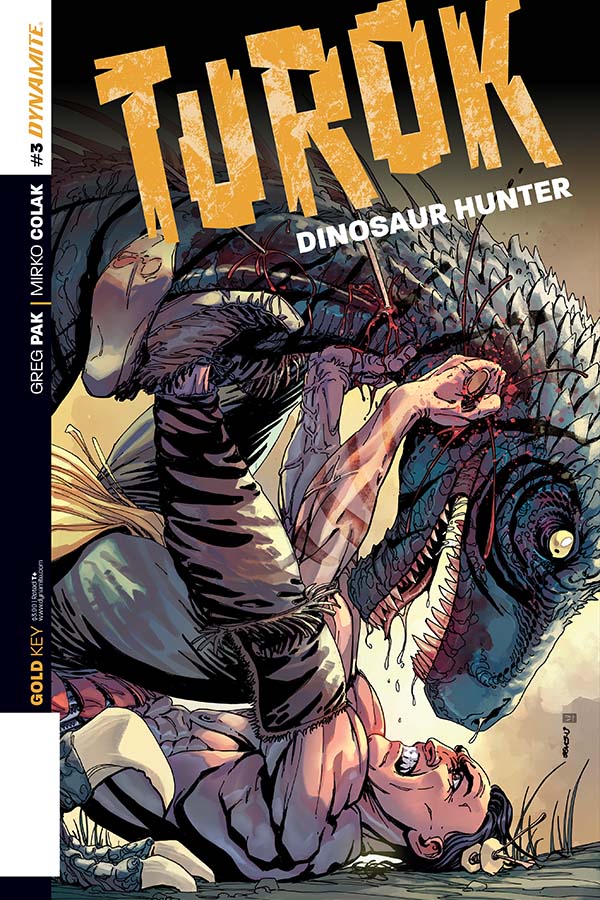 TUROK #3
TUROK #3
Writer: Greg Pak
Artist: Mirko Colak & Cory Smith
Colors: Lauren Affe
Publisher: Dynamite Comics
Price: $4 (Digital)
The more I’ve been reading this new TUROK series, the more I’ve grown enamored of the setting. I mean, it’s not particularly original; it’s just an alternative history story where dinos never went extinct but TUROK’s riff is somehow more distinctive. I can’t even say way for sure but I’m confident it’s not just the grittiness of it either. Regardless, reading the comic makes me itch to run a tabletop game based around it or play a videogame of it, though not another FPS. No, if they wanted to get me on board, they should look at the best dinosaur related video game of all time: ‘Dino Crisis.’
Greg Pak understands that the core appeal of TUROK isn’t really Turok himself but the terrifying way his world is different from ours. But Pak is also wise enough to give Turok just enough genuine character to keep the reader anchored. Take this issue, for example; in a key turning point for Turok that has been subtly hinted at, his sullen attitude belies a human side as he leads to safety what remains of a tribe he never belonged to. Well, tries to. It’s a moment that’s well sold, given his prior faltering regarding his outsider status and it has more to do with seeing that he’s actually being respected for his skills by the younger survivors that’s softened him. I was concerned that would happen unnaturally but Pak has let me down gently.
But there’s also the simultaneously puzzling and interesting development of the “invaders,” especially the girl Marion, who despite being taken captive by the natives, behaves surprisingly though as we see by his father’s callous dismissal of her safety, her risky behavior isn’t unusual, and that’s intriguing as Pak doesn’t want all his invaders to be total villains, especially as one of the other invading soldiers mounts a rescue attempt in spite of his leader’s orders. I’m not sure whether I want to like Pak’s villain for being so unrepentantly (and perhaps unrealistically) awful but then he’s also supposed to evoke the worst parts of invading conquerors and that’s successful here.
What I’m not so sure about is Turok’s odd spasm of compassion for the would-be rescuer. Going from begrudgingly offering to save the surviving natives to risking his neck for an invader simply because he is “brave” seems a bit of a jump. But maybe Turok actually relates to the invaders more than he does his own tribe? That actually could be the case and further reflects on how nuanced Turok’s character might be, if I’m actually giving Pak the credit he deserves here. But what worries me is the internal dialogue from Turok as he sees that Marion is too frightened to help her rescuer and compares himself to the rescuer. Who is Turok’s Marion? Kita? Despite the fact that prior issues have hinted at this, I’m loathe to even think it, because Kita is far stronger and more worthy of Turok’s respect than Marion. Maybe he’s just referring to his tribe as a whole? That makes more sense to me but the parallels to the Turok/Kita relationship are troubling. The last few pages are pure, enthralling action with a nice shot of humor to it, capping off nicely a rather intriguing if uneven story.
The art from Mirko Colak and Cory Smith, is as unadulterated quality as it has been in prior issues. The increased visual presence of the dinosaurs really amps up the energy level overall, their designs and poses drawing the eye in whatever panel they’re in. Some of the panels are just monumentally epic, such as the deployment of the second carnivore. I don’t want to say too much more about the art is I would have to give away some of the best parts of the story but suffice to say, it’s really impressive work all around. And I would be remiss if I didn’t mention Lauren Affe’s on-point coloring, which I settled into finally with this issue. It might not be as atmospheric or bombastic as I’d like but it serves more to flesh out the world and immerse us in it than draw attention to itself, which is a feat. Similarly, Marshall Dillon’s letters convey just the right level of intensity for the dino roars and screeches without interrupting the hustle. Especially satisfying is his “dino chomping on a horse” FX, positioned for minimum profile but maximum impact, which he contrasts later with a fantastic, transparent but overwhelming roar from the new arrival that blots out a whole panel, again, without taking away from the art itself.
Pak’s TUROK is a comic that has more nuance than I ever expected it to have. I am still a bit shaky on Turok’s motivations but Pak is playing a longer game and I’m glad that most of his characters are more than two dimensional, the villain being a lone exception. It doesn’t hurt that this above-average writing is paired with some of the best, if not THE BEST, art that Dynamite has put out. So yeah, TUROK is easily worth the $4 an issue cost. Go get on it ASAP.

